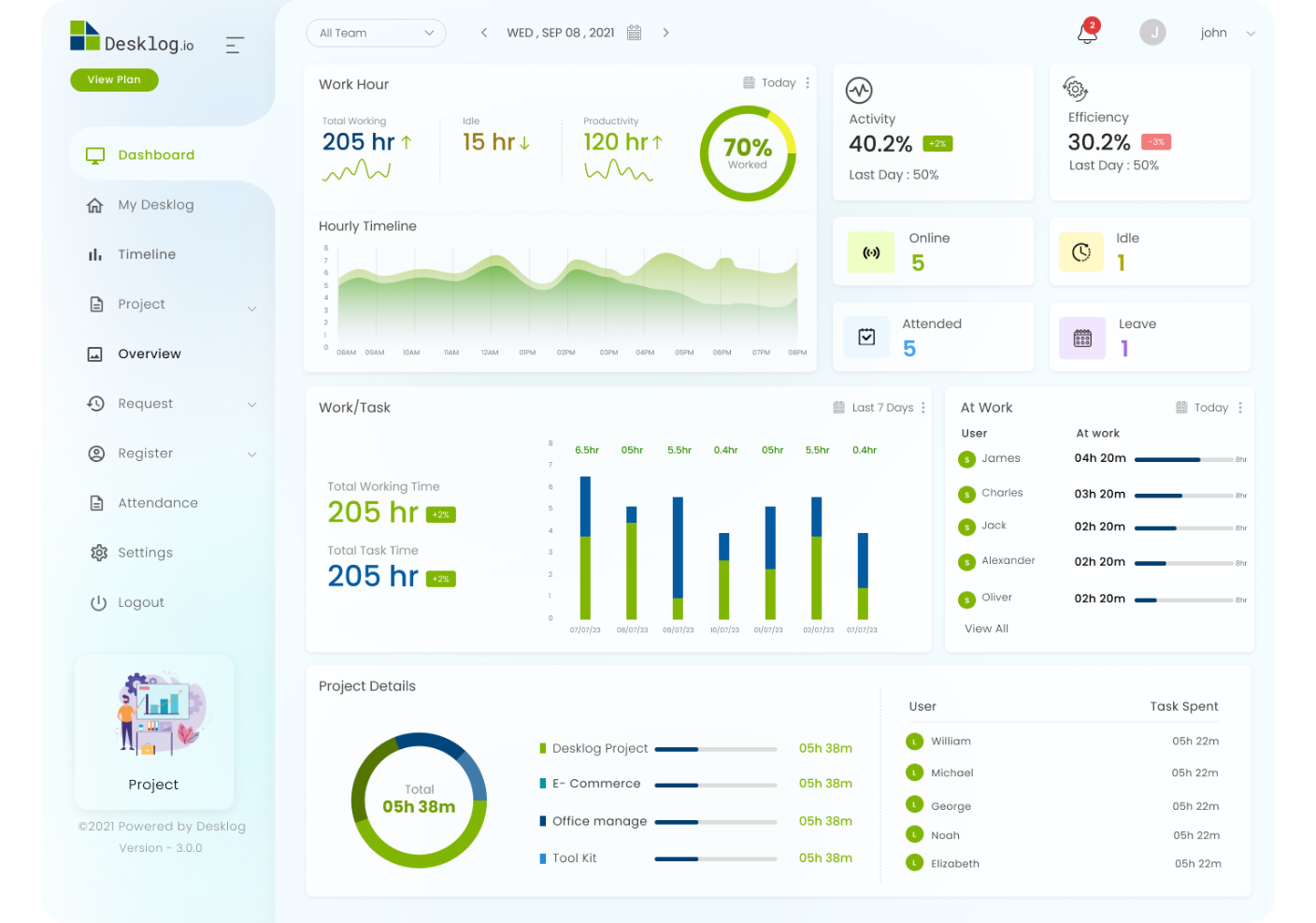Beginner’s Guide on Scrum Methodology And Project Management
Are you a techie? Or working in any software development firm, then you would have definitely heard about scrum methodology and project management software development life cycle.
If you are not into the software development sector and you don’t have any idea about the scrum software development life cycle, then you are in the right place to learn about this agile and scrum methodology and process. This article will help you to find a beginner’s guide on scrum methodology and project management.
Desklog.io is the best project management software to manage all your projects
Before looking into scrum methodology, I hope you all know about the waterfall software development life cycle (SDLC) model. Waterfall SDLC is a process to develop, test and maintain the software product. It is a step by step process. Will see the basic steps involved in SDLC in order to understand the scrum methodology very well.
- Firstly you need to gather information from the client or should understand the requirements of the software product
- As per the requirements design the product by developing with the help of coding
- Test the product
- The product goes live into the production environment
- Maintain the product with post-deployment support
Here in waterfall SDLC, the requirements are gathered in the initial stage and the customer is able to see the product only after the deployment stage. In between no changes are incorporated.
So what happens if the project is quite a big project, where concurrent testing and development activities to be implemented in the between the initial and final stage of the product, Yes! here the agile methodology came into the process.
Also for the best performance and productivity of the employees you can use the leading employee monitoring software that will help you to monitor your employees performance and productivity. Desklog is one among such software.
Want to try our Time Tracking Software?
Try Desklog for free!

What is Agile Methodology?
Agile methodology is a practice to incorporate the continuous changes in the software development process. The changes are performed in continuous iterations to fix the requirements or bugs in development or testing phase of the product.
Whenever you hear about Agile, there comes a word along with it and that is scrum methodology.
Learn about Agile and Scrum management
What is the Scrum Methodology?
Scrum is a type of agile methodology or you can say it as a framework of agile. Here it mainly focuses on how the task is managed in the software development process to complete the assigned task every 2-4 weeks.
It might be a bit confusing for newcomers to understand the Agile and Scrum methodology difference.
The main difference between Agile and Scrum Methodology
As I already discussed, Agile is a practice where as scrum is a type of framework. Agile methodology practices means it includes a set of methods which are according to Agile Manifesto. Self-organization, collaboration, cross-functionality are the features of Agile methodology.
Whereas Scrum software development framework means it mainly focuses on how to implement these features of agile methodology. So it is understood that there are many types of Agile methodologies and Scrum is one of the agile methodologies.
A Short History of Agile
In the middle of the ’90s, Dr. Jeff Sutherland founded scrum agile methodology, when companies pestered him with the projects which were out of budget and schedule. This leads to the research of scrum software development process and it was implemented by the Japanese Companies. Due to the successful series of projects, Agile was into the software development process.
Who Uses Agile Scrum Methodology?
Usually, it is used by the software development team. It is one of the most popular agile methodologies and widely used by all the software team to develop the product.
The usage of scrum management is not limited only to the software team and this scrum software development framework is also beneficial for other types of projects.
There is a saying by a certified scrum master that “If the project is very large and complex and need to produce a solid product, it is always advised to go for scrum management”.
The role of scrum software development methodology has been moved to different sectors other than software development. Different business sectors like FBI, Construction crews, Marketing agencies started implementing scrum management for their business operations.
Scrum methodology and project management helped them to organize the task, team to do the work faster than before. They started receiving successful deliverables before the deadline.
When it is used by almost all the business sectors, in common we can look into the benefits of Scrum management.
Benefits of Scrum management
Roles involved in Scrum
To understand scrum methodology in software project management, you need to know the scrum team or the roles involved in the whole scrum team.
It is very easy to understand and it does not require any special skills to understand or start the scrum management.
Scrum Team
Usually, the team consists of around 7 members and there will be no team lead to assign the tasks or to lead the team to solve the problem. The team is organized and responsible to take up the tasks to fix the issues and solve the problem.
Each member is responsible for the error-free final product and should accomplish the tasks from the initial stage to the final stage of the product.
Let us look into the main roles involved in the scrum team
The product owner is the person who represents customer or client requirements, interest in the product. He is the key stakeholders of the project.
He is the only point of contact who decides the requirements of the product based on the vision and mission of the product built by the developers. He is the only person accountable for the entire product backlog (product details) and approves the completed tasks of the work.
A scrum master is a person who supports or facilitates the scrum team to follow the scrum theory, rules, and values. This will allow the team to implement the changes quickly and helps the whole scrum team to understand and implement the changes in accordance with the agile methodology to achieve the high values of the scrum management.
He helps in removing the project impediments, conducts scrum meeting, and thus finally helps the product owner to brush up the backlog.
The development team is the scrum team that works on the development of the product based on the scrum theory and rules. It is a cross-functional, self-organizing team to deliver the status of the iterations to implement the changes in the product.
There is no lead role in the team and only the scrum master assists the team to accomplish the product backlog into the final products.
Parts and Process of Scrum
The product backlog is a document which contains the details of the product. It includes the requirements for a system, product. It is a document which contains the list of tasks to be completed in order to achieve the final product.
This product backlog is managed by the Product Owner. The new changes or the requirements are added to the product backlog.
A sprint is a certain time frame during which the iteration is performed to implement the changes. Each iteration of the changes is called sprint. Usually, sprints will be implemented within 2 to 4 weeks and it may also take a short time of 1 week.
This is a certain time-framed team meeting to plan which product backlog will be implemented and how to complete the task.
It is a short meeting where each team member will share the progress of the task from the last completed stand up. They also share any task impediments involved.
Once the sprint is completed it goes for the review. In the sprint review, the product owner either accepts or rejects the work completed in the sprint? It will be based on the predefined acceptance criteria. The clients provide their feedback on whether the whole task meets their business needs.
Here the up and down of the completed sprint is discussed and it gives suggestions to improve the next sprint. The scrum team with the master attends the retrospective and this opportunity allows the whole team to enhance the performance and productivity of the team.
Do you want to replace your current project management? Give a try to Desklog.io, the best project management software with scrum methodology.
With effective scrum project management software, you will be able to plan your software development project.
Know how to empower project with project management software
The basic steps to be involved in scrum management
In scrum management, it is based on the servant leader model. You can choose the roles like product owner, scrum master, development team as already discussed in this article.
Enter the final product details, requirements in the product backlog.
Assign the time period for the sprints (Iterations to implement the changes) and complete the task within the time period.
Enter the details of the last sprint in the sprint backlog which will be the reference for the next sprint.
Review the sprint and if required go for a retrospective.
Scrum Methodology and Project Management
The most important part of scrum methodology is its transparency in completing the task. All the members of the team will be aware of the work progress status.
Scrum board is used to organize and prioritize the tasks to be completed.
Select the project management software with effective scrum board and the following features in the scrum board to detect the workflow of the task to be completed.
The benefits of iterations in scrum management
Like transparency, another important feature is iteration. This iteration is performed to incorporate the changes required in between the phases of the scrum software development life cycle. It enhances team efficiency and the quality of the product.
Why are these Iterations Important?
These iterations are very important to receive the feedback from the client before the final stage of the product and you can improve the quality of the product to meet the requirements as the predefined acceptance criteria based on the client requirements. Whereas imagine in SDLC waterfall model, the customer or the client needs to wait until the production of the end product and then the customer feedback is collected after the product goes on a live environment.
This will take more time to fix bugs after the production stage. Instead with the iterations in scrum management the bugs, requirements are fixed concurrently before the deployment phase of the product.
Advantages of Scrum
The scrum methodology is implemented by teams all over the world. Let’s have a look at some of the advantages of scrum methodology.Disadvantages of Scrum
Just like any other methodology, scrum has some disadvantages too. Let’s have a look at the disadvantages of scrum methodology.- Higher chances of project failure if team members are not highly committed or cooperative
- Implementing Scrum structure in bigger teams can be difficult
- Scrum can only be functional with trained team members
- Regular meetings may not be pleasing for all team members
- A team member leaving in the middle of a project can have an immense adverse impact on the project
- Quality is difficult to achieve till the team goes through a rigorous testing process
Conclusion
Hope in this article, you will be able to find the complete beginner’s guide on scrum methodology and project management. Wisely choose the project management software with agile and scrum methodology to manage your project more effectively.
This article will help you to understand the scrum management from scratch and it will assist you in choosing the best project management software to improve the overall productivity of the team, the quality of the deliverables.


